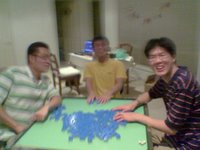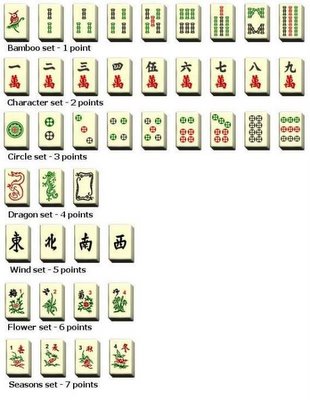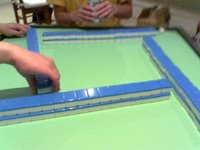Mahjong For Beginners
 Mahjong is a traditional game that originated in China and is a very strategic game. The game is very addictive (ask anyone who has played) because it contains so many variations and requires the player to make lots of decisions. The game is played with 4 people, although 3 people can play but in my opinion you shouldn't bother playing unless you have 4 people. The number of tiles and just the general rules mean its tailored for 4 people. Here is a picture of a recent mahjong game I went to. From left to right are Johnny ("Let's play faster"), Kevin ("Someone get me a drink") and Justin ("Decisions decisions"). I think my mahjong nickname is "If you don't risk you don't win".
Mahjong is a traditional game that originated in China and is a very strategic game. The game is very addictive (ask anyone who has played) because it contains so many variations and requires the player to make lots of decisions. The game is played with 4 people, although 3 people can play but in my opinion you shouldn't bother playing unless you have 4 people. The number of tiles and just the general rules mean its tailored for 4 people. Here is a picture of a recent mahjong game I went to. From left to right are Johnny ("Let's play faster"), Kevin ("Someone get me a drink") and Justin ("Decisions decisions"). I think my mahjong nickname is "If you don't risk you don't win".
Above: All the different types of tiles in the mahjong set
The aim of the game is to get your 13 tiles and the 14th one you pick up into 4 sets of 3 tiles and a pair of tiles. To get your tiles into combos of threes, you can either chow (a straight in poker i.e 2, 3, 4 etc of the same pattern), pong (triple of same pattern), kong (4 of the same pattern). So basically thats all that the games boils down to. You begin by mixing up the tiles properly (below left) and then you build the wall where players then take turns picking up tile from (belwo right). You hope to get 4 sets of those 3 combos and a pair of tiles before the others to win.
Left: Mixing the tiles. Right: The wall, with some discrete product placement for Jim Beam Bourbon and Cola.
However to REALLY learn how to play mahjong, there are many other things you need to learn, such as where to start picking up the tiles to the how to replace and order of play. The hardest thing to learn thoug is the scoring system, which will dictate how you CAN and WANT to play. To explain the scoring system would take a whole book so I'll leave it to you to borrow a book from the libarary yourself. But there are many intracacies in mahjong, for example if you pong the correct wind for you seat you get an extra point, if you self pick a tile to win you get an extra point etc etc. Points are extremely important because with each additional point, you get a doubling of the money that you win. So winning a game with 8 points does not equate to winning two games of 4 points. Since each point is a doubling of winnings, 8 points is actually 16 times the money of 4 points, hence the need to know how to extract every single point possible.
The winner in each round either gets paid from the person who threw out the tile that gave the winner the winning hand or everyone pays if the winner self picks the tile from the wall (the stack of cards in a square as shown in the picture above). The game gets really tense near the end of each round as usually everyone has a chance of winning and so when you discard tiles you have to assess whether the rewards of winnning your hand is worth throwing out something that can cause you to lose.
Anyway I hope I have piqued your interest in mahjong so you go and grab a 3 friends and learn how to play this very enjoyable game. Mahjong sets nowadays can be bought at a number of Chinese book shops or antique shops or over the internet. Have fun and always remember, "WINNING IS EVERYTHING, ITS THE ONLY THING".






0 Comments:
Post a Comment
<< Home